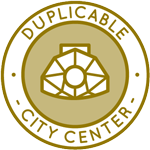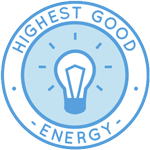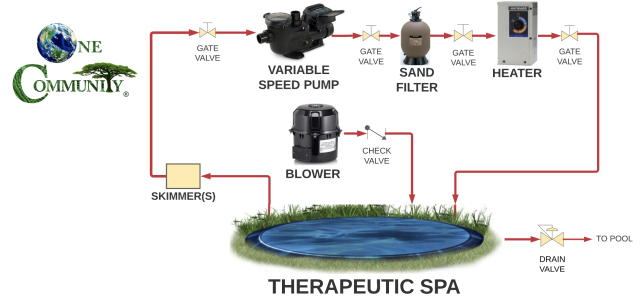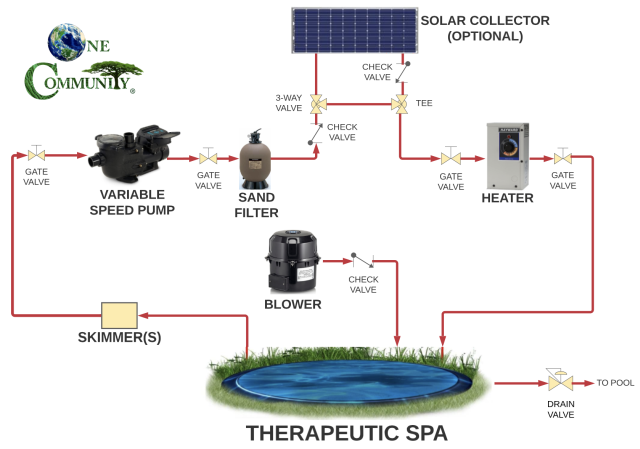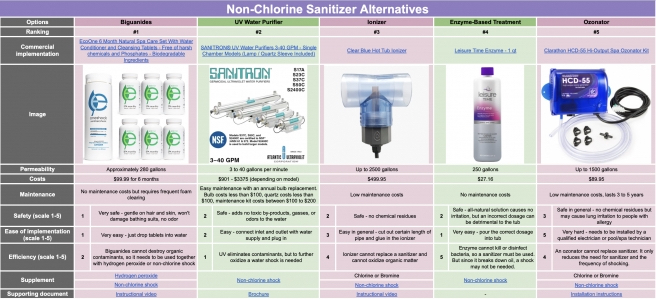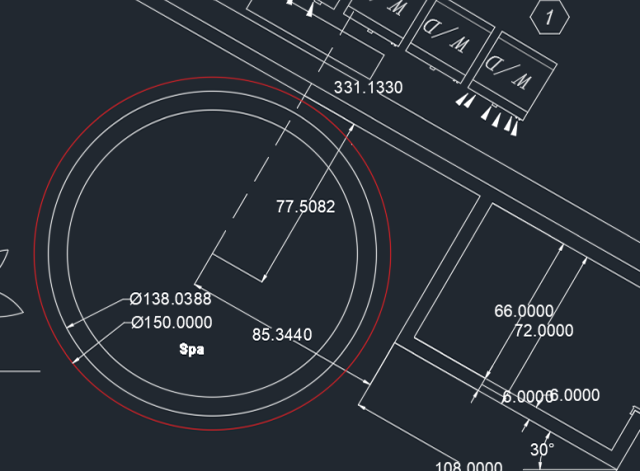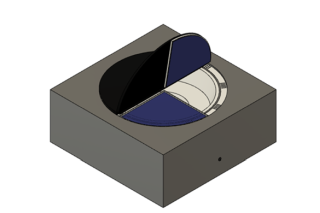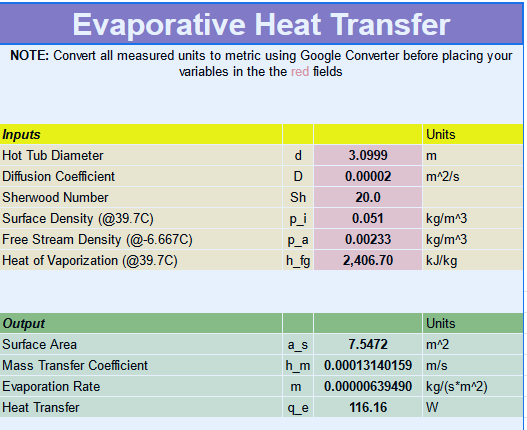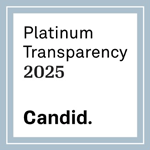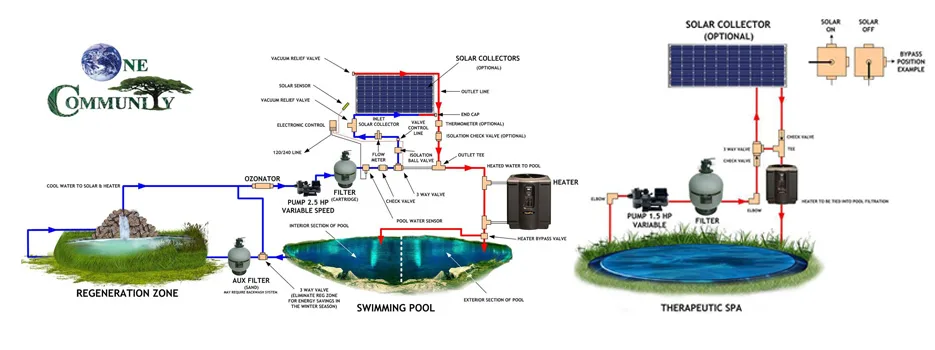
Duplicable City Center Natural Pool & Spa
This page is the open source and free-shared design and construction page for the Duplicable City Center natural indoor/outdoor swimming pool and eco-spa. This page will continue to evolve until it includes complete open source and free-shared county approved comprehensive building plans, purchase orders, construction instructions, editable CAD downloads and Sketchup files, construction tips and tricks, maintenance details, and all other needed specifics for duplication and care of this natural pool and eco-spa as parts of the Duplicable City Center or as stand-alone components.

The One Community Duplicable City Center | Eco-Pool Concept Render ” Indoor view
After that it will evolve even further through global collaboration and sharing the evolutions and adaptations of other people’s projects using these templates and plans. This page includes the following sections:
- Related Pages
- What is a Natural Pool and Eco-Spa
- Why an Open Source Natural Pool and Eco-Spa
- Ways to Contribute to this Open Source Component
- Key Consultants to this Component of One Community
- Natural Pool and Eco Hot Tub Details
- Eco-Spa 3D Models
- Equipment
- Control Panel
- Pumps
- Blower
- Heaters
- Filters
- Water Purification
- Chemical Automation
- Hot Tub Sanitization Alternatives
- Foundation
- Lighting
- Plumbing
- Spa Cover
- Thermal Analysis of Cover Options
- Waterfall Adjacent to the Spa
- Mechanical Room
- Bill of Materials
- Transition Door
- Energy Requirement Calculations
- More Details Coming
- Resources
- Summary
- FAQ
RELATED PAGES
WHAT IS A NATURAL POOL & ECO-SPA
A natural pool is a pool that functions safely without the use of chemicals; in this case, using ozone, germicidal UV, bio filters, and Hayward sand filters utilizing recycled glass to maintain clean and healthy water. An eco-spa is a hot tub designed to function safely with the minimal use of chemicals; in this case using ozone to minimize chlorine use. Some of the key features and intentions for the Duplicable City Center natural pool and eco-spa designs include:
- County approved plans
- Powered by 100% off-grid energy
- Outdoor wading pool lush with plants
- Central pool with indoor/outdoor swimming access to the Social Dome
- Verifiably safe water quality with minimal or, in the case of the pool, no chemical use*
- Ability to completely close the indoor/outdoor transition point for heat retention (see below)
- Ability to be duplicated independently of the Duplicable City Center and independently of each other

The One Community Duplicable City Center | Eco-Pool Concept Render ” Inside court looking east
* We will install a chlorine-feeder for emergency situations and will utilize an ORP meter to gauge safety. The chlorine feeder and ORP meter will allow this design to meet code is almost any county. This statement from Del Ozone leads us to believe chlorine will never be needed: “The Solar Eclipse uses DEL’s proprietary Plasma Gap Ozone Technology (patent pending) combined with high output, low-pressure germicidal UV lamps to make a potent yet economical AOP system small enough for residential pools. This system takes advantage of one of the chemical reactions that create an Advanced Oxidation Process: ozone irradiated by UV light in the 254 nanometer wavelength produces hydroxyl free radicals”

The One Community Duplicable City Center | Eco-Pool Concept Render ” Indoor view

The One Community Duplicable City Center | Eco-Pool Concept Render ” Inside court looking northwest

The One Community Duplicable City Center | Eco-Pool Concept Render – Outside view looking northeast
WHY AN OPEN SOURCE NATURAL
POOL & ECO-SPA
![]() We want to inspire more people to build natural swimming pools and eco hot tubs. We’re doing this because it supports healthier people and a healthier planet and we know that open source sharing these designs, the permitting process, the building process, the safety-testing process, maintenance, and all the specific benefits of a pool and hot tub like this will hold huge value to a broad diversity of people. Additionally, we know if we make these designs easy enough, attractive enough, and provide enough of the foundations to also make them affordable enough, then the other benefits will promote themselves and help more and more people to start investing in this more sustainable option. As part of One Community’s global-change methodology, we see this as having the potential to produce an entirely new mainstream interest in these kinds of designs and all the benefits they provide, growing and promoting the entire industry and all people and businesses associated with it.
We want to inspire more people to build natural swimming pools and eco hot tubs. We’re doing this because it supports healthier people and a healthier planet and we know that open source sharing these designs, the permitting process, the building process, the safety-testing process, maintenance, and all the specific benefits of a pool and hot tub like this will hold huge value to a broad diversity of people. Additionally, we know if we make these designs easy enough, attractive enough, and provide enough of the foundations to also make them affordable enough, then the other benefits will promote themselves and help more and more people to start investing in this more sustainable option. As part of One Community’s global-change methodology, we see this as having the potential to produce an entirely new mainstream interest in these kinds of designs and all the benefits they provide, growing and promoting the entire industry and all people and businesses associated with it.

The One Community Duplicable City Center | Eco-Pool Concept Render – Outside view looking down
WAYS TO CONTRIBUTE TO THE NATURAL POOL AND ECO HOT TUB
SUGGESTIONS | CONSULTING | MEMBERSHIP | OTHER OPTIONS
KEY CONSULTANTS TO THE NATURAL POOL AND ECO HOT TUB DESIGNS
Charles Gooley: Web Designer
Da Ku: Mechanical Engineer
Diwei Zhang: Mechanical Engineer
Jennifer Engelmeier: Eco-pool and Spa Equipment Specialist
Jieying “Mercy” Cai: Sustainability and Climate Policy Researcher
Julia Meaney: Web and Content Reviewer and Editor
Luis Manuel Dominguez: Research Engineer
Meg West: Landscape Architect, Permaculturalist, and founder of Meg West Design
Rick Ruggles: Swimming Pool Equipment and Health Consultant with Hayward Pool Products
Rob Gjerde: Swimming Pool Design & Construction Expert and owner of Sorico Design and Consulting
Rushabh Bhavsar: Mechanical Design Engineer
Sandesh Kumawat: Mechanical Engineer
NATURAL POOL AND ECO HOT TUB DETAILS
A natural pool and eco-spa will provide a relaxing and enjoyable environment for public and resident use at the Duplicable City Center. In order to continue achieving efficient and sustainable designs that align with our purpose at One Community, detailed research and engineering has been completed to develop a design that optimizes energy usage and reduces chemical needs. Equipment, materials, plumbing, and overall design details follow for both the pool and spa. Images and renders have been included to create a visual understanding in support of the corresponding descriptions.
We discuss this with the following sections:
- Natural Pool Layout
- Eco-Spa Layout
- Eco-Spa 3D Models
- Equipment
- Control Panel
- Pumps
- Blower
- Heaters
- Filters
- Water Purification
- Chemical Automation
- Hot Tub Sanitization Alternatives
- Foundation
- Lighting
- Plumbing
- Spa Cover
- Thermal Analysis of Cover Options
- Waterfall Adjacent to the Spa
- Mechanical Room
- Bill of Materials
- Transition Door
- Energy Requirement Calculations
- Resources
- Summary
- FAQ
NATURAL POOL LAYOUT
The layout for the natural pool includes optional solar collectors for passive water heating assistance, natural filtration, backup chemical sterilization, and a pump system with a heater bypass valve that will allow for bypassing the outdoor sections of the pool for winter energy savings:
Here is the plumbing layout and plan for the natural pool. They include optional solar collectors for passive water heating assistance, natural filtration, backup chemical sterilization, and pump system with a heater bypass valve that will allow for bypassing the outdoor sections of the pool for winter energy savings:
ECO-SPA LAYOUT
The eco-spa layout features sand based filtration and a maximally efficient heater and blower. Below is the plumbing layout and plan.
If a solar collector were to be added to this system, here’s what that would look like.
ECO-SPA 3D MODELS
Below is a SolidWorks model of the spa design and implementation. The image depicts the foundation of the spa that uses aircrete and cinder blocks. The tub frame is then connected to the equipment via piping for air and water. This allows the water to circulate back into the system and the jets to be powered by air. The equipment can be accessed in the mechanical room for any maintenance or modifications that need to be made. When not in use, the hot tub can be covered fully or partially to conserve energy using the blanket and cover. To add to the relaxation of the environment, natural colors and a waterfall have been incorporated.
Here are the flow types for the plumbing of the system.
EQUIPMENT
Here is the list of equipment for both the pool and spa. We’ve chosen what we believe will be the safest and most eco-friendly options. We also selected this equipment package to meet code anywhere in the US.
This is what the equipment listed here is sized for:
- Pool size estimate: 16,757 gallons
- Spa size estimate: 1,338 gallons
Here are the equipment specifics that have been selected thus far. The rationale for selection is below:
POOL
- DEL AOP 50 (Previously known as Solar Eclipse) In ground Swimming Pool Ozone and UV Generator
- DEL Ozone 25 (Previously known as Eclipse 1) and 9-0210-11 Install Kit
- Hayward W3HP21004T HEATPRO Electric Pool Heat Pump
- Hayward Commercial Sand Filter HCF363T(F)
- Zeobrite Sand Alternative Media (made with Zeolite)
- Hayward CAT 4000 Automated Chemical Feeder (Wi-Fi)
- Hayward Crystalogic LED Light (including Niche and 300W Transformer)
- Hayward Automatic Skimmers
- Hayward Low Velocity Square Drain Covers (Suction Outlets)
SPA
- Hayward OmniLogic HLBASE 4 Relay Base Panel
- Hayward Tristar SP32900VSP Variable Speed Pump
- Hayward SPB152 Spa Blower
- Hayward C-SPA-XI 11kW Heater
- Hayward S180T Top-Mount Sand Filter
- Hayward Crystalogic LED Light (Including Niche and 100 W Transformer)
- Hayward Automatic Skimmers
Here are more specifics on the best equipment set we’ve come up with to balance energy efficiency, effectiveness, safety, ease of maintenance, and chemical consumption.
CONTROL PANEL
The control panel is the centralized intelligence of the system, designed to optimize and facilitate power to all components used in the design. Panels can be controlled via remote or app in order to manage components or monitor the systems performance.
POOL
Not chosen yet.
SPA
Hayward OmniLogic 4 Relay Base Panel
This panel allows an optimized setup process, with each component having outlined electrical connection pins and a software controlled relay system. This control panel can be connected to a router/access point to communicate with it wirelessly. There is a downloadable OmniLogic Application that can control the functions once set up. This allows the user to simply connect the components to the panel and program the system’s settings via the app.
All electrical components should be wirable to a central control system that outputs 240V or 120V of electricity. Wiring schematics for each component are shown below to give guidance for wiring this central control panel.
The control panel includes:
- 4 high voltage (120/240V) relays to control pumps, pool lights, yard lights, water features, chemical dispensers and more.
- 4 automatic valve actuators including pool and spa valves, water feature valves, cleaner valves and more.
- 4 heaters or low voltage equipment connections including gas heaters, electric heat pumps, and solar heaters as well as various low voltage devices.
- Inputs for 4 temperature sensors or external input devices.
- Ethernet port for wired connection to a router/access point allowing communication to devices on the home network or on the web.
- 125A electrical subpanel that can accommodate up to 12 circuit breakers
The connections and wiring can be seen below for each part that is included in our design.

Schematic of Hayward OmniLogic 4 Relay Base Panel
Note: Click this link for the free app used to develop the image above.
PUMPS
Pumps provide movement of water for pool and spa systems. They are commonly built as an impeller powered by a motor to circulate water so it can be filtered, heated, and returned to the main area. These pumps vary in size, motor speed, and volume flow rate, which all contribute to its efficiency. For each system it is important to understand its unique demands.
In the spa industry, pumps can be built with heating incorporated and this saves space. These dual-purpose pumps are often used for spas around 400 gallons in size. Using a heating pump in larger operations can be difficult because of the larger energy demand and the reliability of the pump. Our system will be 1300 gallons and operating at all times, meaning the pump needs to be durable and reliable under these higher loads.
Variable speed pumps allow for the pump to operate over a range of speeds to suit a wider variety of designs. They also allow the system to switch from low to high flow rates and vice versa. Instead of alternating flow between two pumps, where one is high and one is low, the variable speed pump allows seamless transitions to meet a user’s demands. For the pool and spa systems, a constant flow will be required to filter and maintain the heat of both systems. Also, a higher flow rate will be required during use to accommodate for heat losses and cooling.
POOL PUMP DETAILS
Hayward W3HP21004T HEATPRO 95K BTU, 230V, TITANIUM, DIGITAL, ELECTRIC POOL HEAT PUMP
To recirculate 20,000 gallons of water, a 95,000 BTU pool pump is required to simultaneously heat and move the water. This pump is unique in its configuration as it combines two tasks into one. A separate pool heater becomes unnecessary in this design and increases performance efficiencies. The flow rate of this unit ranges from 30-75 GPM with a maximum water pressure of 50 psi.
SPA PUMP DETAILS
Hayward Tristar SP32900VSP Variable Speed Pump – 3 years parts & labor
The designated turnover rate for the spa design is every half hour, meaning that the entire volume of the spa should be recirculated within half an hour at the least1. With a volume of 1,338 gal, a minimum flow rate of 44.6 GPM is required to meet this standard. The flow rate of this pump is going to operate between 45 and 130 GPM depending on the usage that’s occurring. When idle and no one is using the spa, it will be circulating water at a lower flow rate to maintain cleanliness and prevent pipe freezing. During use, when jets need to operate and heat losses will be high, the flow rate will be higher.
CALCULATING PUMP HEAD LOSS
To understand the energy usage of the pump we must look at the energy expenditures and losses. For the pump, energy is drawn from a power source and turned into mechanical power via a motor. This pump pushes water through piping and creates circulation. Energy is lost when the pump pushes water through the piping as a result of friction and turbulent water flow. This loss can be accounted for by calculating the total head loss of water while being circulated.
This pump is designed to circulate water throughout the entire system and provide various flow rates during operation to maintain heat levels. This pump pushes the water through the filter and heater along with approximately 50 feet of piping, 27 90-degree elbows, and 4 check valves. This piping accounts for roughly 239 ft of water head loss when operating at a maximum flow rate of 130 gpm and a water temperature of 120 F.
To understand the total head loss, elbows and valves create additional head loss that can be added to that of the straight piping. The equations below are:
![]()
![]()

![]()
![]()
1 Utah Admin Code Section R392-302-16
![]()
![]()
![]()
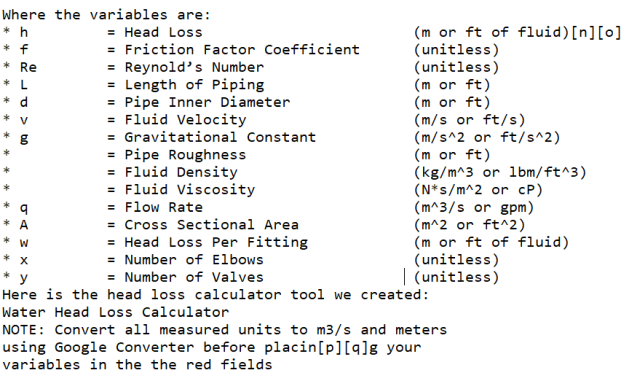
BLOWER
Some pumps also offer the option of mixing air and water to remove the need for a blower by use of a venturi in which the atmospheric air is mixed with the flow of water. In these cases, the temperature of the atmospheric air can affect the heating performance of the tub. Using a blower that is compatible with the pump’s speed is recommended as it will prevent hot tub temperatures from reducing.
SPA BLOWER DETAILS
Hayward SPB152 Spa Blower
The selected blower is designated to have a flow rate around 600 GPM, which seems a lot in comparison to water, but the differences in densities created this discrepancy. This blower suits the needs of our system by providing sufficient airflow to the jets when in operation.
CALCULATING BLOWER HEAD LOSS
Piping is also installed for the blower to run adjacent to the water lines. The friction of air in PVC will determine the proper size blower for the spa. The head loss calculation uses the same methodology as the Water Head Loss Calculation and is shown in the table below.
HEATERS
Heating systems for pool and spa systems are designed to regulate the temperature of flowing water through a heat exchanger which can be heated with natural gas or electricity. To keep the system renewable with as little maintenance necessary, an electric heater will be used for this system. The electric heater provides heat independently (unlike the natural gas one) from outside air making it optimal during cold winter months and nights. The heater is also compact, silent during use, and has a low environmental footprint.
The heater for these systems can be designed separately, or jointly. The benefit of having individual heaters is being able to provide heat to each body of water, at different specifications, simultaneously. This allows both systems to be consistently in operation at full capacity. The downside of multiple heaters is installation costs and maintenance of more parts. These problems are outweighed when considering energy efficiency. The ability to manage the performance of each body individually allows for easier optimization and adjustments.
Heaters can also be combined with pumps to save space and power. This is more common with pool systems as they need larger units to circulate water. Adding a few more pieces to a large component can make the installation and management of the single system more user-friendly.
POOL HEATER
Hayward W3HP21004T HEATPRO 95K BTU, 230V, TITANIUM, DIGITAL, ELECTRIC POOL HEAT PUMP
This heater is dual-purpose and has a heating power up to 95,000 BTU.
SPA HEATER
Hayward C-SPA-XI 11kW Heater
This heater works in conjunction with the pump that has been selected for this application due the adjustable nature of the system. This heater acts as a pipe for water to pass through and is adjusted on and off through communication with the control panel. Sensors read the temperature values back to the control system and adjust the heater’s output.
The size of this heater is also more favorable to our design, as smaller heaters that do not contain pumps provide less power and longer heating times. The opposite is true for most market heaters that contain pumps. These components are generally too large for our application and are more frequently used in pools. Utilizing the selected heater is more suited for this system due to the good balance it provides from both technologies.
The heating is the most fundamental part of the system and accounts for a majority of the efficiency calculations. These are discussed in detail in the Energy Requirements Calculations section below. The following calculation tool shows the projected time and energy required to reheat the spa after a cleaning or refill. These events will occur especially frequently during the beginning of the system operation while system performance is verified and any issues are corrected.
OPTIONAL SOLAR HEATING
Solar heating panels can also be added to utilize solar power to generate heat to a system renewably and sustainably. This component has lots of potential but when assessing the practicality, solar heating has some difficulties. These are mainly due to the location of the spa and the distance solar-heated water would need to travel. Additionally, even if it had the necessary sunlight, it still wouldn’t be enough to heat the spa fully or year-round, so a secondary heat source would still be needed. The possibility remains for a solar heater used in conjunction with a standard heater, but not for our project.
If implemented for other projects, the solar panel below would be the recommendation:
Aqua Solar Controller and Heat Panels ASC-2P-A-LV – 2″/2.5″ 3-way valve with GVA-24 valve actuator and 2 sensors
FILTERS
POOL FILTERS
Hayward Commercial Sand Filter HCF363T(F) ” 36″, 1,050 lb., 36-144 GPM ” 5 years parts & labor
SPA FILTERS
Hayward S180T Top-Mount Sand Filter – 18.5″, 30-120 GPM – 3 years parts & labor
This is a sand filter, but we’ll replace the sand with a Zeobrite Sand Alternative. The filtration rate of this sand alternative rises to approximately 3 microns, where sand only filters down to between 20-40 microns. The benefits of this choice is that Zeobrite lasts as long as sand (approximately five years), it increases pool water clarity, reduces backwashing, and reduces chemical demand and the need to superchlorinate. The only drawback of Zeobrite usage in this filter is that backwashing periodically is required and this adds to water consumption. The benefits outweigh the negatives substantially for our application.
WATER PURIFICATION
It should be noted that the idea of a truly chemical free pool, that gets used regularly and is permitted in a commercial environment, is not a complete reality with the technology that exists today. Code in most areas requires adequate sanitization as well as backup sanitization. UV/Ozone and Ionization are good “alternative” sanitizers, although not without their own health concerns and controversy. But neither have a significant residual effect (ionization has a slight residual effect, but it takes so long to kill microorganisms that disease can easily spread). Chlorine, with all its controversy, is still the best sanitizer for killing microorganisms in the pool because it is both fast acting and has residual effects.
So our goal is to make this a potentially chemically free pool by connecting the chemical controllers, listed below, to the UV/Ozone/Ionizer as the primary sanitizer. The chemical controller would only inject small amounts of heavily diluted chlorine as a secondary backup safety system when contaminants enter the water that the “alternative” sanitizing unit can’t handle in a timely fashion. This way we will:
- Absolutely minimize the use of chlorine
- Keep the pool up to code, healthy and safe to swim in
- Collect and share objective data on exactly how many chemicals we are able to eliminate and how natural an eco-code-compliant commercial pool can actually be
Also, the chemical control unit will constantly measure the pH, and adjust it down to our set point using, ideally, a liquid acid feed pump and tank, with heavily diluted muriatic acid. There are several reasons why these chemicals are important in adjusting and stabilizing pH. First is the pH of a human eye is about 7.4, eye drops are usually about 7.5, and anything above or below will likely result in eye irritation. Second, even though the plan will be to not use much chlorine, it is pH dependent, and the closer to neutral the more effective it becomes by significant logarithmic jumps, so if we make what little chlorine we use more effective we will use much less. Plus, what little chlorine that does get introduced into the pool will have a short half-life with the UV generator and the sun.
WATER PURIFYING PLANTS
Here is a list of water purifying plants under consideration for growing in these natural pools. This list is from the book Growing Clean Water by Bill and John Wolverton and purposed for the most extreme water purification situations:
- Water hyacinth (Eichhornia crassipes) “the most effective plant and easy to grow ” prolific”
- Kudzu (a prolific growing plant)
- Sorghum (uptake of contaminants goes into tops of plant mostly)
- Tomato (uptake of contaminants goes into the leaves mostly)
- Duckweed (Lemmna, Spirodela and Wolffia sp.)
- Alligator weeds (Alternanthera philoxeroides)
- Arrow arum (Peltandra virginica)
- Arrowhead (duck potato) showy white flowers
- Giant bulrush (Scirpus californicus)
- Soft-stem bulrush (Scirpus validus)
- Calla lily (Zantedeschia aethiopica)
- Canna lily (Canna sp.)
- Cattail (Tipha sp.)
- Elephant ear (Colocasia esculenta)
- Ginger lily (Hedychium coronarium)
- Maidencane (Panicum hemitomon)
- Pickleweed (Pontederia cordata)
- Common Reed (Phragmites communis)
- Soft rush (Juncus effusus)
- Torpedo grass (Panicum repens)
- Water canna (Thalia dealbata)
- Water iris (Iris pseudacorus)
- Water pennywort (Hydrocotyle umbellata)
In the book it is suggest to feed the plants to keep them producing. When a plant is full of contaminants (we’re not yet clear on how the average person would be able to determine this), disposal and replacement of the plant is suggested through composting (for non-food use) or burning.
CHEMICAL AUTOMATION
The following hardware has been identified as the best choices for each of our bodies of water. What you see below control primary and secondary sanitization systems and the pH balancing systems. All of the CAT controllers include a 5-year limited warranty on controllers and 2-year warranty on the sensors. The HCC controller has a 1-year warranty on the controller with factory labor.
POOL SYSTEM
Chemical Feeder: Hayward CAT 4000 Automated Chemical Feeder (WI-FI)
This component communicates anywhere in the world via Wi-Fi. Remotely control and view water chemistry through apps or web, receive alarms indicating problems. Web-based management requires monthly subscription
Sanitizer: Cambell Environmental Systems – 10-year warranty
- NSF approved
- Multi stage units alternate between UV and copper/silver ionization.
- With the secondary chlorine tank, one chemical controller listed above would be effectively using three different and effective methods of sanitization.
Chemical Feed Tanks & Pumps: Stenner Tanks System
These two tanks come with attached chemical feed pumps, for each body of water. One will be used for housing diluted liquid chlorine and the other diluted liquid acid. There is a 1-year warranty on these tanks and chemical pumps. Diluted liquid chlorine is used as a secondary sanitization system.
Surface Cleaner: Solar Breeze Ariel Smart Robotic Pool Cleaner
This cleaner targets the water surface and continuously skims the surface all day and into the night, when able to catch some solar rays. It uses zero electricity and has a 50 micron filter that is constantly filtering the dirtiest water in the pool, which is on the surface. It’s also able to catch a greater volume of large debris compared to most skimmers.
Pool Floor Cleaner: Hayward Tiger Shark Plus RC9955 – 5 microns filtration at 75 GPM
This system will clean the entire floor surface of the pool including steps and tile, and it has a beach entry sensor. This cleaner provides significant ease of maintenance. It can be put in the pool for a couple of hours when needed, or on a regulated schedule, just plug it in and walk away. It also comes with a remote control for spot cleaning.
SPA SYSTEM
For the spa system, a wide range of chemicals can be used to maintain the pH and total alkalinity at appropriate levels. The easiest way to incorporate these chemicals is through an automated feeder that is constantly checking for changes in these values and designed to dispense the appropriate volume of substances to maintain values within the optimal range. Ideally, a spa should have a total alkalinity range of 80 – 120 ppm, and a pH between 7.2 – 7.8.2
Maintaining the correct pH and total alkalinity is important for the safety of the users and maintaining the longevity of the spa. Irregular pH and total alkalinity can result in poor water clarity, sanitizer deficiency, skin and eye irritation, and deterioration of hardware.
If the pH rises above 7.8, the water is becoming too alkaline. When water is too alkaline, it reduces the effectiveness of chlorine, the pool chemical that kills pathogens. Total alkalinity, on the other hand, refers to the ability of the pool water to resist a change in pH. So total alkalinity is key to helping control the pH in the pool.
Additional readings that are important are sanitization and total hardness. Sanitization describes the concentration of the sanitizer being used to effectively eliminate viruses and bacteria. For chlorine, this level should be within 1.5 – 3.0 ppm and for bromide, 3.0 – 5.0 ppm.2 Total hardness refers to the calcium hardness of the system which describes the mineral content of the water for calcium and magnesium. This metric should remain between 250 – 450 ppm to prevent equipment corrosion.2
Some common parasites, viruses and bacteria controlled by chlorine are Salmonella, Campylobacter, and norovirus. If left uncontrolled, they can cause diseases and serious complications making it paramount to remove these germs.3
There is parity between chlorine and bromine in their applications as they both achieve the same goal of terminating harmful germs. They are able to fight off the same microorganisms through different chemical reactions. Chorine uses oxidation and bromine uses ionization. Bromine is able to continually disinfect for a longer duration, but the oxidation reaction of chlorine causes germs to die quicker. Chlorine works more effectively than bromine but needs a bit more maintenance. Aside from this difference, the next notable factor is their cost, with chlorine costs averaging about half as much as the price of bromine and dispersion equipment has an even larger discrepancy. Both are very useful and accomplish the same target, with one being slightly more advantageous for our applications.
Water hardness is important for entirely different reasons. Controlling water hardness is needed to maintain the integrity of the metal components within the system. Comment end If water is too hard, calcium and magnesium buildup can happen on the heating elements and gaskets. This leads to corrosion and shorter operating life.
Spa Automated Feeder: pH/ORP Controller with Hanna Cloud Connectivity
This chemical automated feeder monitors the level of pH and sanitation taking the hassle of constant monitoring away for these metrics. The feeder uses potassium chloride (HI70300L pH Electrode Storage Solution) as a buffer to balance the pH and sanitation of the system.
This feeder does not check for the total alkalinity which should be checked once a week to ensure pH accuracy is maintained. This can be done using the HI775 Freshwater Alkalinity Colorimeter. Generally, sodium bisulphate and sodium bicarbonate are used to adjust the alkalinity of the spa lower or higher respectively. Numerous compatible options are available on the market and each provides its own tailored dosage based on spa volume.
Also, total hardness should be checked once a month using the HI735 Total Hardness Low Range Colorimeter. This value is adjusted using calcium chloride. Much like the total alkalinity, numerous chemical options are available on the market and each provides its own tailored dosage based on spa volume.
HOT TUB SANITIZER ALTERNATIVES
Chlorine and bromine are chemicals widely used in hot tub sanitization. They can kill bacteria and prevent algae from growing and thus keep the water clean and clear. However, chlorine and bromine are very toxic and cause damage to human tissue. These two chemicals are corrosive and can enter the body through breathing and skin contact when bathing. Skin irritation and organ damage are possible outcomes of exposure to chlorine and bromine. The severity of skin irritation or organ damage can vary depending on several factors, including the concentration of the chemicals, the length of exposure, the individual’s pre-existing health conditions, and more. For example, exposure to low concentrations of chlorine or bromine may cause irritation of the eyes, nose, throat, and lungs. High concentrations can cause more severe symptoms, such as coughing, wheezing, and chest pain, and can also lead to lung damage and other serious health effects.
Moreover, chlorine and bromine have negative impacts on the environment. For example, when chlorine is released into the air or water, it can react with other substances to form harmful compounds such as dioxins and chloroform. These compounds can be harmful to wildlife and can persist in the environment for extended periods of time as it takes a long time for them to break down.
Given the harmful health and environmental effects they create, this section will introduce several sanitizer alternatives to chlorine and bromine. The recommended options may not be able to fully eliminate the use of chemicals in hot tub sanitization. Still, they can reduce the needed amount and contribute to healthier and more eco-friendly hot tubs.
Sanitization and oxidation are two necessary processes to fully clean hot tub water. Sanitization eliminates bacteria and purifies water while oxidation breaks down oils and organic contaminants. Although some sanitizers can oxidize, their effectiveness cannot be compared to an added oxidizing agent and it is suggested to use both. The following options are alternatives to chlorine and bromine sanitizers, thus a non-chlorine shock (an oxidizing agent), such as Oxone and Potassium Monopersulfate, or an enzyme-based treatment (explained below), is recommended to use as a supplement to all of them. Below is our open source spreadsheet for our recommended hot tub sanitizer alternatives.
SANITIZATION
Water sanitization is the process of eliminating bacteria, algae, and other harmful microorganisms from water to make it safe for human use. It is crucial to prevent the spread of waterborne diseases and infections. Several methods are available for water sanitization, including chemical sanitizers, UV water purifiers, ionizers, and ozonators. Each method has its advantages and disadvantages, and choosing the appropriate one depends on factors such as the type of water to be sanitized, the desired level of effectiveness, cost, and environmental impact. In this context, understanding the various water sanitization methods and their pros and cons is vital in making informed decisions regarding hot tub water treatment.
#1 BIGUANIDES
Biguanides are an organic compound derived from guanidine, which can be found naturally in foods such as turnips, mushrooms, and corn. Biguanides act as an all-natural sanitizer for hot tubs and can replace chlorine and bromine. They control the growth of bacteria, algae, and other microorganisms that can cause harm to bathers. They work by forming a protective barrier on the surface of the water and preventing contaminants from growing. This barrier remains active even in high bather loads and hot temperatures, making it an effective way to maintain a clean and safe hot tub environment. Biguanides are sustainable and cost-saving non-chlorine alternatives. They have a lower environmental impact as they do not create the same harmful byproducts as chlorine and bromine. They also do not have a strong odor, which can be more pleasant for hot tub users. Additionally, biguanides are effective over a longer period, which means less frequent application is needed, reducing the amount of chemical waste produced.
One notable thing about biguanide is that it interacts with other substances in water, such as soaps, lotions, and oils, and thus creates foam. The foam itself is not harmful but will reduce the sanitizer’s effectiveness. Therefore, it is recommended to use a defoamer (e.g. SpaPure Defoamer) in combination with biguanide to remove this foam and ensure the optimal result.
Biguanides also cannot break down body oil and organics in the water and it is thus suggested to use them together with non-chlorine shocks or enzyme-based cleansers.
Advantages:
- Adds no chemicals to the water and thus causes no skin irritation or damage to bathing suits.
- No strong odor, which can be more pleasant for hot tub users.
- Sustainable and cost-saving due to their low environmental impact and long-lasting effectiveness.
Disadvantages:
- May lose effectiveness over time as some microorganisms may develop immunity to it.
- Create foams that reduce the effectiveness and thus have to use with a defoamer.
Our recommended product: One 6 Month Natural Spa Care Set With Water Conditioner and Cleansing Tablets – Free of harsh chemicals and Phosphates – Biodegradable Ingredients
How to apply: Add biguanides to the hot tub water in the recommended amount and leave them circulating throughout the water. It is important to note that foams need to be removed to ensure the effectiveness of biguanides.
See the video for instructions: The BioGuard SoftSwim Chlorine-Free Care System (Biguanide)
#2 UV WATER PURIFIER
An ultraviolet (UV) water purifier radiates water with UV light to kill microorganisms and sanitize water. The UV-C light can alter the DNA/RNA of bacteria and viruses and thus destroy their ability to reproduce. In a hot tub, UV water purifiers are usually installed on the circulation line, where the water passes through the purifier and is exposed to UV light.
UV water purifiers are highly effective at sanitizing hot tub water as they kill a broad range of microorganisms including bacteria, viruses, and parasites. They are sustainable chlorine and bromine alternatives because they do not introduce any chemical byproducts into the water and can thus create chemical-free and environmental-friendly hot tubs. Additionally, UV water purifiers do not consume a lot of energy to operate because the electrical energy required to power the UV lamp is typically low, making it an energy-efficient option for water purification.
However, it is important to note that UV water purifiers are not a standalone solution for hot tub sanitization. They are not effective at breaking down organic matter, such as body oils and other contaminants that can accumulate in hot tub water. Therefore, it is recommended to use UV water purifiers in conjunction with non-chlorine shocks or enzymatic cleaners for optimal hot tub sanitization. Additionally, UV water purifiers do not remove contaminants or debris from the water, so regular filtration is still necessary to keep the water clean and clear.
Advantages:
- Adds no hazardous by-products to the water and causes no skin irritation.
- Cheap and easy to maintain with annual bulb replacements. They do not require large amounts of electricity or water to operate, and the bulbs used in the purifiers can last for up to 12 months with proper maintenance.
- Sustainable, energy-saving, and adds no chemicals to the water.
Disadvantages:
- Dust on the bulb will reduce its effectiveness. Dust particles that are floating in the air can settle on the bulb’s surface, creating a layer of dust that reduces the amount of UV light that can penetrate the water passing through the purifier. The accumulation of dust can also reduce the efficiency of the bulb and increase the amount of energy it needs to operate. Therefore, regular cleaning is needed.
Our recommended product: SANITRON® UV Water Purifiers 3-40 GPM – Single Chamber Models (Lamp / Quartz Sleeve Included)
How to apply: To apply a UV water purifier to a hot tub, you will need to install the purifier into the hot tub’s filtration system. The installation process will vary depending on the specific purifier and hot tub you have, so it’s important to follow the manufacturer’s instructions carefully. In general, the purifier will need to be mounted in the hot tub’s filtration system so that the water passes over the UV bulb.
See the video for instructions: Ultra Violet Light Installation Guide for UV Water Filter Systems
#3 IONIZERS
Ionizers reduce 80% to 90% of algae, viruses, and bacteria in the water by releasing silver and copper ions. When the ionizer is installed in the hot tub, the copper and silver electrodes in the device release positively charged copper and silver ions. These ions are attracted to negatively charged microorganisms and once they attach to them, they disrupt their cellular structure, making them unable to reproduce and survive. As a result, the growth of these microorganisms is reduced, and the water in the hot tub remains clean and clear. As it cannot fully eliminate all contaminants, a low level of traditional chlorine or bromine sanitizer, typically around 1 to 3 parts per million (ppm), is still needed in the process.
Ionizers also do not oxidize the water and a non-chlorine shock or enzyme-based treatment is required for better-sanitizing results.
Advantages:
- Increases the life expectancy of spa covers and equipment as it adds no chemicals to the water.
- Easy installation and low maintenance.
Disadvantages:
- Higher initial cost. Purchasing an ionizer costs more upfront compared to chemical sanitizers. However, it can save you money in the long run.
- May cause stains on the pool shell because copper and silver ions react with sunlight and shock and create stains.
Our recommended product: Clear Blue Hot Tub Ionizer
How to apply: Connect the ionizer to the hot tub’s plumbing system, usually by inserting it into the filter or attaching it to a separate injection point.
See the video for instructions: How to install a ClearBlue pool ionizer
#4 OZONATORS
An ozonator is a cheap and long-lasting non-chlorine water sanitization option. The machine injects ozone gas into water and disinfects harmful contaminants. The ozone gas works by breaking down the molecular structure of these contaminants, effectively neutralizing them. Ozone is an effective sanitizer that leaves no chemical residue in the water, making it a popular option for those who want a more natural and eco-friendly approach to water treatment.
One limitation of ozonators is that they may not be able to effectively remove some organic matter and certain types of bacteria, such as cryptosporidium and giardia. One solution to this limitation is to use ozonators in combination with enzyme-based cleaners and ultrafiltration, or just a small amount of chlorine and bromine if you prefer. Enzymatic cleaners use natural enzymes to break down organic matter in the water, reducing the amount of food available to bacteria and other microorganisms. Ultrafiltration is a water filtration process that uses a special membrane to remove particles and substances from water. The membrane has tiny pores that allow water and small molecules to pass through, but block larger particles and contaminants like bacteria, viruses, and other harmful substances. To apply ultrafiltration, you will need to use a membrane with a pore size of 0.01 to 0.1 microns in your hot tub filter or simply purchase a built-in ultrafiltration hot tub.
Advantages:
- Long-lasting effect, change the ozonated water every 8 to 12 months.
- Create a chemical-free and eco-friendly hot tub.
Disadvantages:
- May cause lung irritation to people with an allergy to the ozone gas.
- Not effective as a standalone sanitizer and can be costly if used in conjunction with ultrafiltration.
Our recommended product: Clarathon HCD-55 Hi-Output Spa Ozonator Kit
How to apply: First, mount the ozonator under the spa cabinet or near the hot tub to allow for proper airflow. Then, install a check valve to prevent water backflow and attach it to the hot tub’s suction tubing. To add an extra layer of protection, create a Hartford Loop by looping the ozone tubing up as high as possible above the water line. Choose your power source by either plugging the ozonator into a wall outlet or hardwiring it to your hot tub’s system.
See the video for instructions: How to install an ozone in a spa.
OXIDATION
Oxidation is a chemical process in which a substance loses one or more electrons, resulting in a change in its chemical composition. In water treatment, oxidation is an essential step in the removal of contaminants, such as organic compounds and body oil. It is achieved by adding strong oxidizing agents to the water, which react with and neutralize the contaminants. Oxidation is a powerful tool that can improve water quality and create a safe hot tub environment.
#1 NON-CHLORINE SHOCKS
Non-chlorine shock, also known as shock oxidizer, is a type of oxidizer used to remove organic matter and contaminants in hot tub water. It works by introducing oxygen into the water, which reacts with contaminants and breaks them down into smaller particles that can be easily filtered out. It is a quick and effective way to reduce unpleasant odors, clear cloudy water, and enhance the overall cleanliness of the hot tub. Some examples of non-chlorine shocks are potassium peroxymonosulfate and peroxy acid. They are both strong oxidizers that eliminate organics in the water but don’t leave a residue.
Advantages:
- No chlorine smell and is safe for sensitive skin. They are typically gentler on the skin and less likely to cause dryness or irritation.
- Compatible with non-chlorine sanitizers.
Disadvantages:
- Costs about 10% more than chlorine shock.
- May not be as effective as chlorine-based shocks in eliminating algae and bacteria. However, this is not a major concern because these two contaminants can be removed with sanitizers.
Our recommended product: SpaGuard 7 lbs Spa Shock Oxidizer non-chlorine
How to apply: For initial treatment, add this product to sanitized water at the rate of 2 ounces per 300 gallons. For regular maintenance, add 1 ounce per 300 gallons once a week. When the spa is subjected to heavy use, the treatment (1 oz per 300 gals) should be made twice weekly.
See the video for instructions: How To SHOCK Your HOT TUB | Swim University
Related resource: Article: “What is non-chlorine shock?”
#2 ENZYME-BASED TREATMENT
Enzymes are biological catalysts that accelerate chemical reactions. They work by lowering the activation energy required for a chemical reaction to occur, allowing the reaction to proceed more quickly and efficiently. They have the same function as an oxidizer as they break down organic matter in the water, such as oils, lotions, and other contaminants that can accumulate in hot tubs and spas. When enzymes encounter a contaminant that they can break down, they attach to it and help to break the chemical bonds that hold the contaminant together. This process continues until the contaminant has been broken down into its simplest components, which can then be easily filtered or otherwise removed from the water. Enzymes are compatible with all kinds of water sanitizers. Additionally, enzyme treatments are often used as part of a regular maintenance routine to help prevent issues from occurring in the first place. It breaks down the molecules of pollutants into small particles, making it easier for sanitizers to disinfect and kill them.
It is important to apply the correct dosage of enzymatic cleaners. As a general guideline, typical dosages range from 1 to 2 ounces per 500 gallons of water, but this can vary depending on the concentration of the product and the level of contaminants in the water. It is always best to start with a lower dosage and gradually increase it as needed to achieve the desired results. Overuse of the product will lead to an overly foamy spa.
Advantages:
- Safer for human health and the environment. Contain natural enzymes that break down dirt and bacteria rather than harsh chemicals.
- Do not affect the pH balance of the water.
- Cost-effective in the long run since they can reduce the need for frequent draining and refilling of the hot tub water.
Disadvantages:
- Can take longer to work than other treatments, as the enzymes need time to break down the organic material in the water.
- Enzymes are sensitive to temperature and pH, and if the conditions are not suitable, their activity can be reduced, leading to reduced effectiveness. For example, some enzymes work optimally at a pH range of 6.0 to 8.0 and a temperature range of 77°F to 104°F (25°C to 40°C). It is thus important to ensure the correct temperature and ph conditions for maximum effectiveness.
Our recommended product: Enzyme by Leisure Time
How to apply: Add 1 ounce of Spa Enzyme per 500 gallons of water once per week.
See the video for instructions: How to have a Chemical Free All Natural Hot Tub www.NaturesHotTubTreatment.com
FOUNDATION
The foundation of the spa is crucial to its performance. While a majority of the heat loss is caused by convection and evaporation, heat still dissipates through the bottom and sides of the system via conduction. Below an image can be seen displaying a 3D model of the projected foundation. This foundation consists of cinder blocks filled with aircrete as additional insulation.
SIZING
The dimensions of the tub are shown below and were determined based on the available space. This system is intended to accommodate 8 to 10 people comfortably with a seat edge length of 19 inches. The seats of the pool sit 24 inches below the surface and the total depth of the pool is double that at 48 inches. The images below outline other key measurements in inches.
MATERIALS
The three materials under consideration for the foundation and the tub frame were shotcrete, gunite and cinder blocks filled with aircrete. Shotcrete and gunite are essentially made from the same material and are similar in their properties to traditional concrete. The only difference is their method of preparation. Both of these materials provide a high grade of structural strength and surface finish. The insulation properties, though, are very low (same as that of concrete) and hence cannot be used as standalone options for our insulation goals.
The third option is cinder blocks filled with aircrete. Aircrete is a mixture of cement, water and foam. The insulation provided by aircrete is considerably greater than its concrete counterparts (R value = as high as 3.9 per inch) but it is significantly less strong structurally. Because of this, cinder blocks will be used as the foundation concrete to give more strength and rigidity. They will then be filled with aircrete for added insulation.
CONSTRUCTION
To begin installation, an outline of the structure is formed with cinder blocks as the foundation. They will provide the necessary structural strength and give the basic shape to the spa. The cinder blocks are filled with aircrete. This will increase the R-value and insulation considerably. Giving us an efficient energy-saving structure. Finally, a layer of concrete (shotcrete) is poured over the cinder block foundation to form the tub frame. By this method, we utilize the advantages of all the materials, provide structural strength, required insulation, and desired surface finish.
Images of the cinder block construction and backfilled scenarios are shown below.
LIGHTING
The lighting of this system provides 24 hour availability to the users and can also be customized to optimize the experience. The selected systems are leading in efficiency and require adapters to perform effectively. For the pool and spa, almost identical components are used, with variance in the niche sizes.
POOL LIGHTING
Hayward CrystaLogic LED Light for Pool (including Niche and 300W Transformer) LSLUS11(030), (050), (100), (150) (cord length)
This light is extremely energy efficient and bright with LED bulbs that will last 10’s of thousands of hours. This product is also UL listed and contains a low-profile all-plastic niche (LFGUY1000) that requires no grounding or bonding. This niche gets tied to rebar so no light box is made of gunite. This saves considerable money over other lights because it uses less materials, such as copper wire for grounding and bonding and gunite for the light box, which saves time and money throughout the installation process too.
Transformer: LTBUY1130, 300W transformer
SPA LIGHTING
Hayward CrystaLogic LED Light for Spa (including Niche) LPLUS11(030), (050), (100), (150) (cord length)
Everything is the same as the pool light except the niche (LGGUY1000) is regular size and requires a light box, however it is still all plastic and does not require bonding or grounding.
Transformer: LTBUY1130, 300W transformer
Accent lights: LAWUS11(030), (050), (100), (150) (cord length), 12v LED, 320 lumens
Small lights designed to accentuate areas in and out of the pool. Fit in 1.5″ threaded fitting.
PLUMBING
The plumbing of this system encompasses the non-electric hardware associated with water movement. This includes valves, drains, jets and adapters that were specifically selected for this system. These components are essential to the successful performance of each system.
POOL
Skimmers: Hayward SP1071S2 – 2″ x 2.5″
Drains: Hayward WG1032LV2PAK2 ” 9″
Pool Inlet Fittings: Infusion VRFTH & Ijet 004-252-3070-01
4-5 return inlets from the following 2 models specifically designed for low-flow pools to dramatically improve circulation. The Infusion has the added benefit of keeping the water warmer with the drawback of protruding further into the pool. The Ijet contains a lower profile in wall color options, but the drawback is that it needs to be replaced about every 5 years.
SPA
The spa plumbing is a bit more detailed as it requires air piping to be installed and includes a waterfall, both in addition to the standard water piping. The standard piping is made up of the same connections required from the pool: the skimmers, valves, fittings and drains.
Skimmers: Hayward SP1071S2 – 2″ x 2.5″
Skimmers capture and filter water from the spa into the recirculating pathway. They are placed on the rim of the foundation at the surface level of the water to regulate the volume. The selected skimmers are detailed below.

Hayward Skimmer
Ball Valves: Midline Valve 832T434-NL Premium Full Port Ball Valve Brass, 2-1/2 in. FIP x 2-1/2 in. FIP
The ball valves are intended to cut off circulation at designated points. These valves are necessary for maintenance of components and potential shutoffs for cleaning. Three valves are placed along the water flow pathway and one along the airflow pathway. The details on the ball valves are provided below.

Midline Brass Ball Valve

Midline Brass Ball Valve Render 832T434-NL Premium Full Port Ball
Three-way Valve: Jandy 4719 Large 3-Port 2-1/2-Inch to 3-Inch Positive Seal Pool/Spa NeverLube Valve
The three-way valve will only be used in the spa to change the path of the water for two options. The primary position will keep the water circulating from the spa to the components. The other position is connected to the drainage line which will allow water to be removed for cleaning or maintenance. Both are necessary for the full functionality of the spa, and can only be accomplished with the three way valve.

Jandy Three Way Valve
Drain: HaywardWG1032LV2PAK2 ” 8″, 125 GPM, 2″ outlet
Drains are not direct links to the drainage system, but rather a connection from the bottom of the spa to the main circulation line. This component acts similar to the skimmers and regulates the volume of the water though its openings

Hayward Drain
Jets: Hayward SP1434PAKA Jetair III Water Body Assembly Replacement ” 4 needed
Before the jets can dispense water and air, the two lines need to be connected through an adapter. This fitting merges the two lines before the jet fitting, as the lines have to be separated to maintain operational fluid flows. This connection is also referred to as the jet body assembly and includes the jet nozzle:

Hayward Jet
SPA COVER
Generally made for portable, or above-ground hot tubs, custom covers can be made to contain heat and protect the hot tub from pollutants. A cover is required to ensure minimum heat loss through the surface of the hot tub when not in use. Standard covers available in the market open halfway and make the spa usable by three to five people while keeping the unused half of the spa partially covered.
To minimize heat loss even more, an idea using a multi-fold standard cover in conjunction with a thermal blanket has been explored. The multi-fold allows ¼ of the hot tub to be used by 2 or 3 people while the other 3/4ths remain covered.
The thermal blanket applies insulation directly to the water surface. By minimizing the water’s contact with the air, heat will need to be conducted through the thermal blanket, and evaporation will be almost eliminated. There will also be an air gap between the cover and the thermal blanket, again increasing the efficiency of the system. Below is a simplified understanding of the layers of the cover.

Hot Tub Cover
The design has not been finalized, but a cover with the potential to fold twice would be optimal for this design.
CLICK HERE IF YOU ARE AN INDUSTRIAL DESIGNER AND WOULD LIKE TO HELP US COMPLETE THIS DESIGN.
This would cater to individual users and small groups, allowing for energy to be conserved while the tub is in use. The less surface area exposed, the less heat loss. Below is a rendering of the framework needed to support the thermal blanket and folding structure of the cover.

Proposed Thermal Blanket Frame
In the covered state, a variety of potential configurations can be observed. The table below displays the advantages of each system and offers a comparison of each value. This analysis of options led to the current design.

Projected Spa Cover Layering
THERMAL ANALYSIS OF COVER OPTIONS
WATERFALL ADJACENT TO THE SPA
A waterfall was implemented adjacent to the spa system to add beauty and the relaxing sound of running water. This system requires the implementation of a few components within the plumbing system such as an additional pump, piping and fittings to complete the circuit. The adaptation can be seen in the image below:
To generate an optimized output the following calculation was completed for the friction loss and total dynamic head:
![]()
![]()
![]()
![]()
![]()
![]()
![]()
![]()
![]()
![]()
![]()
![]()
![]()
![]()
![]()
MECHANICAL ROOM
The mechanical room is the storage room that will house the components that operate the system. This room is intended to protect the components from the seasons and conceal some of the projected noise during use. It also conceals the complicated plumbing, which improves the aesthetic of the overall spa area. Here are images showing how the inside of this area will be organized:
BILL OF MATERIALS
Below is a full list of the materials necessary to construct the hot tub area. The amount of units and costs are outlined, along with energy requirements for select items.
Pool bill of materials still needs to be completed.
TRANSITION DOOR
As shown above, the actual swimming pool is an indoor/outdoor pool. Below are two design plans for the transition point.
TRANSITION DESIGN PLAN 1 ” DOOR
Here is a design plan for a door structured to be able to be closed anytime it would be beneficial. Examples of when this might be desirable would be insulation in the winter, sound control when events are being hosted inside or outside, and separation of the swimming areas whenever needed. Da Ku‘s heat loss calculations for this design in a worst case scenario (subzero outdoor temperatures) is around 325W, which is the energy lost per second, for a total evening energy heat loss of around 4kWh, or 0.014 MMBtu.
Cost Analysis:
- Plexiglass doors: $522
- Gasket: $99
- Hinges: $106
The price for a 0.5″ thick, 35″ * 75″ plexiglass is around $261, we need two of them, so $522 (source). The gasket we’d need is around 740 inches, so the total cost is around $99 (source). Continuous hinges cost $26.50 each and we need 4 for a total of $106 (source).
TRANSITION DESIGN PLAN 2 ” UNDERWATER OPENING
Transition design #2 is two underwater openings, one for movement out of the building and one for movement into the building. This is what we are planning now because of its benefits for the City Center HVAC design. By using two below-water openings through the 6″-thick wall instead of a door, we’ll be able to eliminate the “constant open window” effect that the door would create whenever it isn’t seasonally closed. An opening like this will still be able to be sealed in the winter months while providing much better insulation efficiency during the rest of the year. Two openings will also be safer than one by having a separate opening for movement in each direction.
Final design details are coming….
ENERGY REQUIREMENT CALCULATIONS
POOL
The pool has two systems so we can close it at the indoor/outdoor transition point in the winter and still keep the pool healthy and beautiful. This requires double the equipment for the pool. Also, some health departments will require an actual presence of chlorine, some will make exceptions, and some realize that ORP is a true measurement of water quality and safety and will base the safety of the pool on that. For this reason, we’ll have the ability to add chlorine to meet code while removing it whenever our ongoing pool water testing shows it’s not needed.
Energy requirements for the pump and other pool components are as follows:
- 2 EcoStars variable speed pumps: Max energy draw (100%, 3450 RPM’s) 2,326 WATTs per pump. Actual estimated pump use on pool (2000 RPM’s) ” approximately 477 WATTs each
- Chemical Automation Controllers: Three CAT 4000’s (15AMP, 120 VAC) approximately 1,800 WATTs (when/if all chemical pumps are operating
- Lights: Two Universal Crystal Logic pool lights (14v, 5amp) ” approximately 70 WATTs
- Solar Controller: (120/240v) ” (periodic use with solar demand)
- Valve Actuator (24v, 0.75amp) ” approximately 18 WATTs (periodic use with solar demand)
SPA
Determining the energy requirements of the spa system involves understanding the operating environment and how it impacts the energy demand of each component. Assumptions about the environment must be made to define the performing conditions which include temperatures, material properties, and other measurements.
Once the general system has been designed, identifying all the energy consuming components was the next step to determine energy usage by determining what rate each component utilizes that energy. Those rates are used to calculate the total power consumption. The power consumption can be compared to the energy loss to understand the system’s efficiency.
The next step in the calculations would be determining the heat losses which occur in 3 different stages: In use and fully uncovered, in use and partly covered, and not in use. These stages cover the overall performance of the system. When fully uncovered, two forms of heat loss occur: evaporative and convective. Each of these stages require a different form of the problem to be solved and contain different target values.
To understand the heat transfer at each stage, the focus of each analysis will be the water’s heat loss. As previously stated, the two main methods of this heat loss are by convection and evaporation. For this analysis, we will assume that the heat lost by conduction, through the ground, is negligible in comparison to the others. Conductive heat loss is not as large of a focus for this model due to the high quality materials being used for insulation. By making this assumption, we can assess the energy transfer to open air for several configurations. This is achieved by simplifying the heat flow to one direction from the water to across the covers. The tables below summarize the findings for those scenarios and provide data to understand the permeation.
FULLY COVERED (CONDUCTIVE) HEAT LOSS
While the hot tub is not in use, it will be covered and maintained at the designated temperature it keeps while in use. This maintained temperature allows access to the spa during all times of the day and makes the situation easier to calculate. This equation is simply a sum of thermal resistances added to find out what combination and orientation of materials provides the least amount of heat loss. The proposed methods were to use a thermal blanket, a hot tub cover, or both in conjunction. Also, the question remains if the cover needs to be flush with the surface of the water, or if adding room below the cover will be more effective. Any components used to retain heat should have a resistance value provided by the manufacturer. The formulas and results from the calculations are shown below:
![]()
![]()
![]()
![]()
To use this calculator, copy the spreadsheet or just copy+paste this table on your own Google Spreadsheet
FULLY UNCOVERED EVAPORATIVE LOSS
Evaporative heat loss accounts for a small portion of the total heat loss, but is still significant to the overall losses. These heat losses are generated by water molecules leaving the system in the form of steam. Water leaving the system is a conduit for heat to exit whenever the surface is exposed to the atmosphere. The formulas and results from the calculations are shown below:
![]()
![]()
![]()
![]()
FULLY UNCOVERED CONVECTIVE HEAT LOSS
This portion of the calculation implies that the hot tub is open to the atmosphere and there is no conductive heat loss. The primary focus is the convective heat loss in this situation when the tub is fully open and the surface is at a constant temperature. This will determine the heat leaving the system from the surface of the water to the atmosphere when in use. The full analysis is shown below:
![]()
![]()
![]()
![]()
![]()
PARTIALLY COVERED HEAT LOSS
This analysis combines the convective and conductive heat transfers to assess the performance of the cover in multiple configurations. The partially covered calculation takes the results from the conductive and convective states to generate the findings below:
REHEAT STARTUP
There are other systematic events that should be assessed too. These include a new startup after a drain and refill and/or a total reheat. This event consumes significant amounts of energy and should be budgeted into the energy calculations. The table below highlights the basic usage of the heater from startup time with cold water and the formulas used to calculate the energy findings.
![]()
![]()
![]()
MORE DETAILS COMING
This section will also continue to expand and eventually include complete permitted plans, downloadable 3-D Sketchup and CAD files, instructional videos covering the entire building process, complete maintenance and upkeep details and instructions, and more. Visit our Helping Page for details on how anyone can assist us in making all of this happen faster.
RESOURCES
General Spa Information:
- Natural Pools on Pinterest
- Article: “Natural Swimming Pools 101”
- Article: “How to Build a Natural Swimming Pool”
- Article: Top 10 tips for building your own affordable DIY natural swimming pool”
- Article: “Natural Swimming Pools: 9 Myths Busted”
- Article: Swimming Pool & Hot Tub Spa How-To Articles
- Article: Understanding Spa and Hot Tub Water Chemistry
- Article: Spa Cover Technology
- Article: Hot Tub Pumps
- Article: Hot Tub Heaters
- Article: Jet Assemblies
- Article: Spa Chemical Guidelines
- Article: CDC Water Disinfection
- Regulation: Utah Spa Code: Admin. Code 392-302-16
- Article: “The Facts About Chlorine”
- Article: “The Facts About Bromine”
- Article: “What is Non Chlorine Shock and What Does it Do?”
- Article: “Running a Hot Tub Without Chemicals for an Eco-Friendly Spa”
- Article: “6 Hot Tub Sanitizer Alternatives To Try (No Chlorine Or Bromine)”
- Article: “Natural Hot Tub Chemicals ” A Chlorine Alternative For The Hot Tub”
- Article: “Let’s Talk Biguanide”
- Article: “Get Clean, Clear Hot Tub Water without using a ton of chemicals”
- Article: “Hot Tub Ionizers”
- Article: “Why you should buy a Hot Tub Ozonator”
- Article: “What is non-chlorine shock?”
- Article: “Environmental impacts of the widespread use of chlorine-based disinfectants during the COVID-19 pandemic”
- Article: “What causes the water to foam in my hot tub?”
- Article: “Biguanide Derivative”
- Product details: “SpaPure Defoamer”
- Product details: “EcoOne 6 Month Natural Spa Care Set With Water Conditioner and Cleansing Tablets – Free of harsh chemicals and Phosphates – Biodegradable Ingredients”
- Product details: “SANITRON® UV Water Purifiers 3-40 GPM – Single Chamber Models (Lamp / Quartz Sleeve Included)”
- Article: “Pool Residual Sanitizer Options Compared: 2021”
- Article: “How an ionizer works”
- Product details: “Clear Blue Hot Tub Ionizer”
- Article: “The Complete Guide to Pool Ionizers”
- Product details: “Clarathon HCD-55 Hi-Output Spa Ozonator Kit”
- Article: “A Quick and Easy Guide to Hot Tub Ozonators”
- Product details: “SpaGuard 7 lbs Spa Shock Oxidizer non-chlorine”
- Product details: “Enzyme by Leisure Time”
- Video: “The BioGuard SoftSwim Chlorine-Free Care System (Biguanide)”
- Video: “Ultra Violet Light Installation Guide for UV Water Filter Systems”
- Video: “How to install a ClearBlue pool ionizer”
- Video: “How to install an ozone in a spa.”
- Video: “How To SHOCK Your HOT TUB | Swim University”
- Video: “How to have a Chemical Free All Natural Hot Tub”
Calculation Analysis Resources:
- Research: Mixed Convective Heat Transfer and Evaporation Analysis
- Research: Aircrete
- Article: Understanding Spa and Hot Tub Water Chemistry
- Tool: PVC Pipe and Fittings Sizes
- Tool: Material Properties and Conversions
- Tool: Waterfall Calculation
SUMMARY
![]() Natural swimming pools and eco hot tubs provide a healthier and more sustainable pool and hot tub environment. This page is the process of open source sharing a chemical-free pool and minimal-chemical hot tub complete with designs and plans, the permitting process, the building process, the safety-testing process, maintenance, and all the specific benefits. We are doing this as part of One Community’s global-change methodology to inspire a new generation of people to build like this and experience all the benefits for themselves and the planet so we can significantly support, forward, and accelerate the mainstream interest, implementation, and further development of these technologies.
Natural swimming pools and eco hot tubs provide a healthier and more sustainable pool and hot tub environment. This page is the process of open source sharing a chemical-free pool and minimal-chemical hot tub complete with designs and plans, the permitting process, the building process, the safety-testing process, maintenance, and all the specific benefits. We are doing this as part of One Community’s global-change methodology to inspire a new generation of people to build like this and experience all the benefits for themselves and the planet so we can significantly support, forward, and accelerate the mainstream interest, implementation, and further development of these technologies.
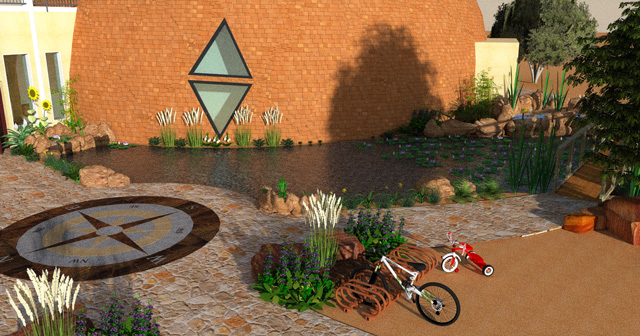
The One Community Duplicable City Center | Eco-Pool Concept Render – Outside landing view
FREQUENTLY ANSWERED QUESTIONS
Q: Has a truly natural commercial pool ever been built in the US?
Yes! Here it is and it is beautiful! Check it out: Webber Park Natural Swimming Pool
If you have a question you’d like answered here, please contact us so we can add it and make this page better.Southwest.
 One Community
One Community